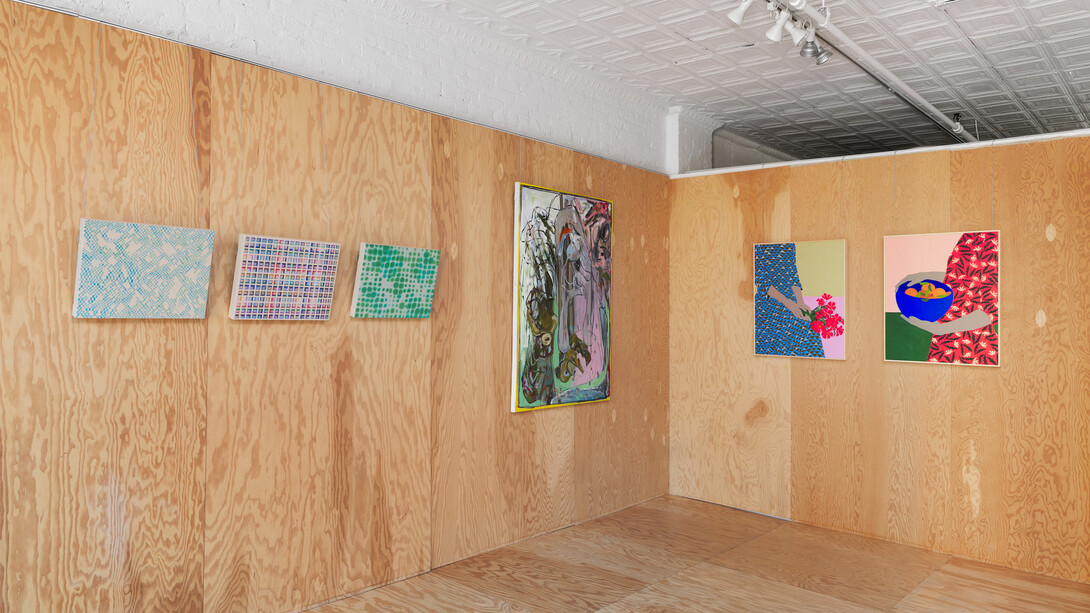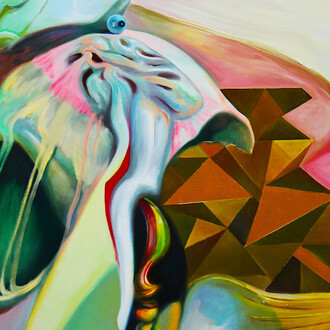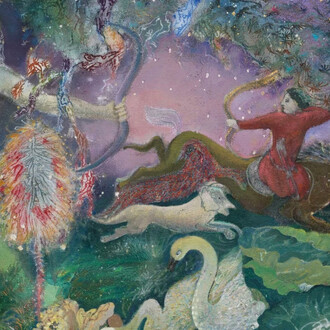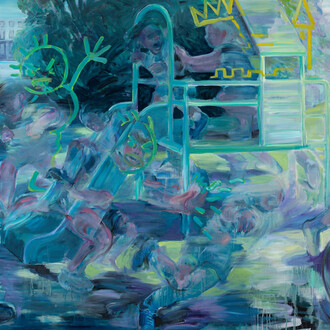Uprise Art’s annual Keepsake exhibition reflects on how artwork can serve as a conduit, carrying a message, recollection, or metaphor from its creator. The 2025 exhibition features new work by Arielle Zamora, Carmen McNall, Christina Flowers, Christina Watka, Dana Bechert, Devon Reina, Diana Delgado, Eddie Perrote, Elisa Gomez, Fitzhugh Karol, Gizem Vural, Jackie Meier, Jessica Simorte, Kate Clements, Kate Roebuck, Kyle Pellet, Lydia Bassis, and Misato Suzuki.
Considering how transient emotion, personal history, and sensory experience can take tangible form, Vural’s abstract colored pencil and pastel works on linen evoke the feeling of a place once known, now accessed only through memory. Quick sketches made while walking are transformed in the studio into meditative musings of a leaf, a scent, an overheard conversation, a fragment of song. Reina’s undulating acrylic and wax pastel paintings similarly hint at forgotten recollections and the shifting mesh of experience, where forms and memories converge and dissolve in tenuous rhythm. In Suzuki’s dreamlike patchworks, hazy impressions surface through impasto layers of acrylic, subtle ombrés tracing the contours of time. Meier’s jewel-toned oil paintings, filled with spiraling and tessellating shapes, open portals to unseen dimensions, suggesting a gravitational pull that binds all things. Circling back to the physical world, Perrote distills the sensory light and atmosphere of Southern California in graphic acrylic paintings, evoking sun-bleached stucco, dry heat, and the scent of chaparral carried on the wind. Gomez translates memory into energetic abstract compositions, capturing moments of joy, nature, and maternal reflection through vibrant fields of color and texture, creating visual keepsakes of her lived experience.
Objects of affection and domestic ritual become carriers of memory and connection, where a keepsake marks love, lineage, and shared life. In Delgado’s gestural oil and acrylic paintings, her children’s stuffed animals appear as mystical totems of care, rabbit ears and velveteen fur peeking through energetic slashes of color, caught between abstraction and figuration. Bassis also finds meaning in the small tokens of childhood, embedding curios collected on nature walks with her child, souvenirs that preserve the presence of a moment and ground attention in the act of noticing. In Roebuck’s work, heirlooms and natural objects transform personal history into universal symbols of sentimentality. McNall reflects on the quiet power of everyday objects, exploring the unconscious ways we carry memory through the vessels around us. Simorte’s intimate acrylic paintings of domestic interiors act as emotional self-portraits in miniature, illustrating how the spaces we inhabit imprint upon us, and us upon them.
Memory also takes the form of place, transforming geography into a container for recollection. Zamora reconstructs fragments of Mérida, Mexico, in carved joint compound, oil, and wax-painted panels, where flashes of color and pattern evoke paint-peeled walls, iron gates, and weathered wooden doors. Through this layering, time and memory intertwine, forming a tactile map of experience. In Karol’s delicate porcelain figurines, a return to clay mirrors a return to rural life, offering the solace of slowness, solitude, and the familiarity of grounded practice.
Natural forms and forces provide another language of remembrance, reflecting impermanence, renewal, and sensory presence. Watka captures light as a carrier of memory through delicate kinetic sculptures of mica and acrylic, inviting viewers to pause and notice subtle shifts in reflection and movement. In glass, Clements explores precarity, beauty, and ecological balance; her four elemental sculptures symbolize the universe’s fundamental forces, reminding us that the true power can be delicate, resilient, and ever- shifting. With a more tactile approach, Bechert carves porcelain vessels and integrates motifs of flora and fauna into their surfaces, creating a tangible record of natural forms where the solidity yet fragility of the material evokes the enduring rhythms and presence of the natural world.
Finally, memory itself becomes a process in the work of Pellet and Flowers, where abstraction, layering, and material accumulation mirror the act of remembering. Pellet’s acrylic panels fragment narratives into rhythmic structures, letting moments of representation coalesce and dissolve, reflecting the temporal complexity of experience. Flowers’ compositions balance organic spontaneity with geometric precision, allowing disparate elements to converge.
In this exhibition, each artwork becomes an intimate record of what they have seen, felt, or wished to preserve. Across a range of techniques and materials, these artists give form to the idea of the keepsake, translating fleeting emotion, familial tenderness, and sensory impression into objects that extend an invitation to remember.
















